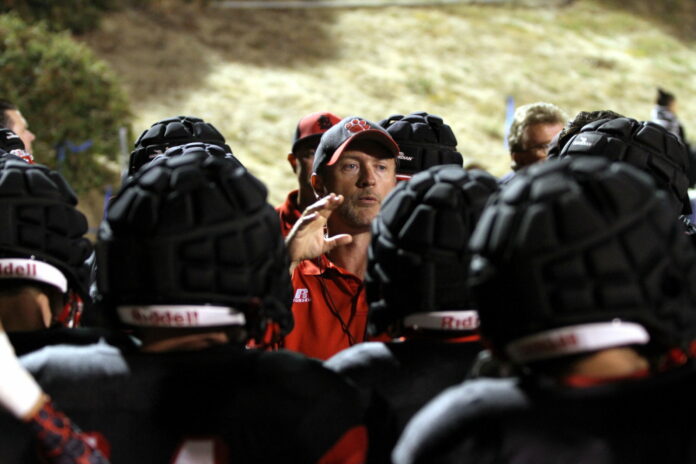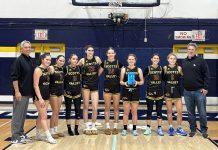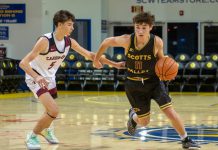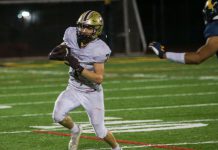The San Lorenzo Valley Cougars are using cutting-edge helmet technology to take some of the sting out of hard-hitting football games.
The varsity and junior varsity players are the only teams in the Santa Cruz Coast Athletic League to use the “Guardian Cap” on their helmets, a one-size-fits-all helmet cover worn over their football helmets.
The “soft shell” helmet cover is designed to reduce the force of impact by increasing the time of deceleration upon impact.
“Football is as safe as it has ever been in the history of the game,” said Cougar Head Coach Dave Poetzinger. “We don’t want to have this technology available and not use it.”
SLV Athletic Boosters, a non-profit organization of SLV parents, fans, and alumni, purchased 100 of the helmet protectors three years ago for $45 each to be used during practice. In 2015, the Cougars used them in the finals and the playoffs.
“The boosters really stepped up to support the kids’ safety,” Poetzinger said, adding that the school has to replace about 10 worn-out Guardian Caps each year.
This year the equipment is being used every weekend when the Cougars (4-2 as of Oct. 14) take the field. The junior varsity team also uses the protection.
“We weren’t getting any concussions in practice but we were getting them during games,” said high school principal and assistant coach Jeff Calden, referring to the transition from practice to game-time protection.
Though certainly not a scientific analysis, there has only been one concussion this year compared to three last year, Poetzinger said.
Parents are rightfully concerned about head injuries.
A 2011 study by Nationwide Children’s Hospital reported 8,631 concussed players ended up in emergency rooms.
“We’re all aware of head injuries,” said Gina Carling, whose son, Mark, plays tight end for the Cougars. “This (Guardian Caps) is a good idea. I don’t see any downside.”
Lee Hanson, founder of Georgia-based Guardian Cap, says his product reduces head impacts by a third. More than 50,000 have been worn to date by high schools and colleges across the United States, Canada and Europe.
“Our goal is to provide the best protection possible,” said Hanson, who stops short of guaranteeing an end to head injuries. “If you want to protect your shoulders, you put on shoulder pads. More padding on anything is better.”
SLV is the only county football team that is using the equipment in games, but some schools may be using them during practice, Poetzinger said. Indeed, practice can be the most-dangerous time.
The majority of high-level impacts occur during practices, according to a 2012 study called Head Impact Exposure in Youth Football.
Poetzinger said he recognizes the Cougars are battling tradition by outfitting the team with the new protective gear.
“Change is difficult,” he said, adding that people also fought seat belts and motorcycle helmets when they were introduced to boost safety.
“But 30 years from now we’re going to look back (on teams not using helmet protection) and say that was crazy,” Poetzinger said.
Head safety, whether a team uses protection or not, is of prime importance, from youth leagues to the pros. Indeed, concussion reporting has become so stringent that many of the injuries reported today would have gone unnoticed several years ago, Poetzinger said.
What that means is the actual number of concussions is on the rise as teams initiate mandated protocol as a matter of precaution.
But Poetzinger maintains that the teamwork, physical activity, and camaraderie of football far exceeds the dangers of possible head injury.
“The kids that aren’t playing sports –those are the kids I worry about,” he said, referring to the use of drugs and alcohol. “That’s really wrecking their brains.”













